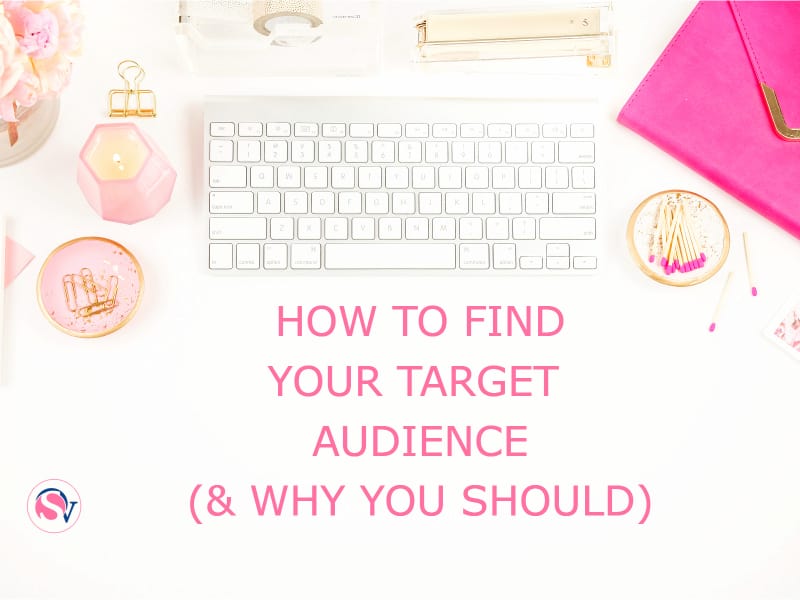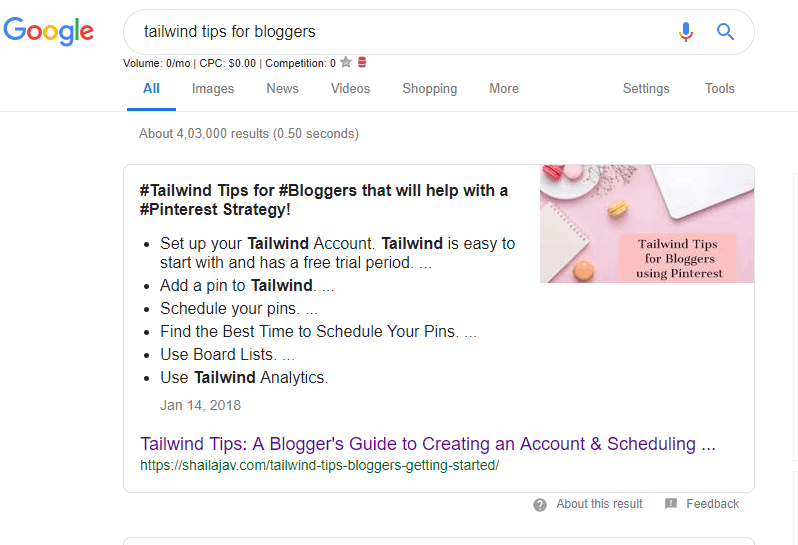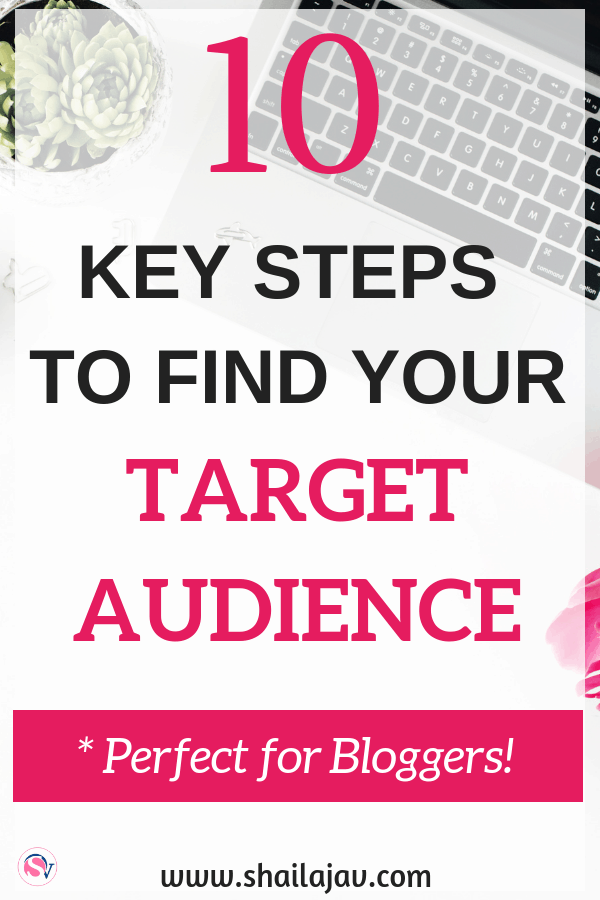Welcome to day 3 of the ‘Plan your Blog’ series. We’ve already covered why you need a bullet journal for your blog and how to set up your blog for success. Today we’re diving into a crucial part of the blogging process: Learning how to find your target audience and why you should.
As a blogger, your primary focus should be two-fold: writing what you know about and writing for the audience that will find it valuable.

This post contains Affiliate links. What that means is if you click on any of the links and make a purchase, I get a commission at no extra cost to you. I only recommend products that I have bought and used myself. If you do use the links, I thank you for your support. Read my complete disclosure policy here.
Why you need a target audience
There are a million blogs out there and counting. Blogging has become more than a hobby now. It’s a way to have your voice heard, exercise authority and earn an income from the comfort of your home.
While this is the fun part of blogging, the hard part is being heard and standing out in a sea of bloggers. Doing these steps outlined in today’s post will help you in a number of ways.
You will grow to be an authority in your domain.
People will trust you and what you have to say, when you do it consistently.
You will grow a loyal, supportive and engaged audience that will do the best favour in return for the work you do. They will speak on your behalf. They will promote your content, without your asking. They will send clients, readers, subscribers and paying customers your way. And why will they do all of this?
Because you took the pains to find your target audience.
- Why you need a target audience
- Identify your niche or niches
- Think Like a Reader
- What does your Audience want?
- Create an Avatar of your Reader
- Where to find your Audience
- Study the Comments Section
- Start a Dialogue on Social Media
- Join Facebook groups in your niche
- Follow Thought Leaders in your Niche
- Use Pinterest Keyword Research
- Tasks for you: Find your Audience
Identify your niche or niches

If you already have a blog or a business, chances are you know what you are going to blog about. To clearly identify your niche, ask yourself these two important questions. Write them down and answer them:
- What do I know enough about already, from experience or education?
- What can I afford to learn about in my chosen space, to help others find answers?
For instance, I started off as a parenting writer, because I drew purely from experience. Over time, I realised that a lot of the books I read, the conversations I was having and the information I received could be helpful to other parents like me.
So, almost by accident, I stumbled upon the ‘yelling less’ journey which roused this blog from a nobody to a somebody. Parents wanted to know how to stop yelling and what I’d done to make it happen.
Today, my post on how I’ve gone over 800 days yell-free is the most-read post on my blog!
Then, late last year, after I’d been actively blogging for over 5 years and having learnt a bit about social media and blogging, I toyed with the idea of expanding my focus. And so today, I write about not just parenting, but also about Pinterest, productivity, blogging and social media in general.
How did I decide that this would be my set of focus areas?
I decided to think like a reader.
Think Like a Reader

It’s great to blog for yourself and very often, I urge people to start blogging that way, because that is how you find your voice. Your unique and authentic style comes through when you’re writing without worrying about what people will think.
But, when you are writing online, with a hope that people will read you and your content, it’s important to keep the reader in mind.
And the only way to keep the reader in mind is to actually think like a reader.
Take your niche, for instance. Think about what you enjoy reading. If you’re a lifestyle blogger, what do you like to read about online?
As a travel junkie, what excites you? Is it the fancy getaways with the luxury pools or the quiet ones on a farm?
As a food aficionado, what food do you whip up? Is it the kind that has easy ingredients or do you like gourmet meals?
The secret to knowing what you reader wants is to ask yourself what you want, as a user.
Nobody explains this better than Meera Kothand in her books. I have bought all of her books listed below and believe me, they have completely changed the way I approach blogging today. Meera (and I) urge you to be authentic yet authoritative.
*I recommend starting with the ‘One Hour Content plan’. Do this side by side with the Create Planner. Then, move on to ‘ But I’m Not an Expert’ and end with ‘How to get your first 100 customers’.
What does your Audience want?

What does your audience want? Asking and answering this question is key to finding out more about them.
Do they want solutions to problems?
Do they want tips to improve something in their lives/blogs?
Or do they just want to be informed and updated about the latest developments in your niche?
Take a sheet of paper and answer these three questions. The more you listen to your audience, the more refined will be your strategy.
Where do you find these questions? Google Search.
Type in a few key words and look at the first page of results. That’s what your audience will see and that’s how you know what content you should create to capture your audience.
My post on Tailwind Tips for Bloggers ranks in the first position of Page 1 on Google and it’s a thrill to see that it comes with the ‘featured snippet’ too! 🙂

Create an Avatar of your Reader

Want to be even more niche in finding your idea audience?
Create an avatar of your ideal reader!
If you have Google Analytics, this is fairly simple to do. Go into Audience>>Gender>> Age group.
You will first see which kind of people are reading your blog. How old they are, whether they are male or female and which country they are from.
Now that you have the broad idea, niche further down and create a person with those attributes. Let’s say I create a mother in her early 30s, who is struggling to manage her time and feed her kids wholesome food while also managing a work-from-home business.
So I would know then that the posts she’d be keen on would be:
- How to create easy, wholesome meals in under 30 minutes that your kids will love.
- How to manage your time effectively while working from home.
- How to keep your kids occupied while you work on your blog.
See what I mean? Niche down to a person and you immediately know whom to write for and what to write about.
Where to find your Audience

This part will take a bit of trial and error, but the good news is your audience actually can exist on more than one platform.
Parents tend to hang out the most on Pinterest, Facebook and Instagram for instance. So it would make sense for me to be where my audience is.
This will also ensure that you’re not spreading your attention across too many platforms but optimizing the ones where your audience is active.
*Meera goes into great detail in her book listed above. Try it. It’s at a throw-away price on the Kindle. 🙂
Study the Comments Section

A place very few people think about looking for their audience is the comments section.
Comments are the life-blood of a blogger. But most bloggers just feel happy about getting comments without realising that there’s a potential gold mine waiting there.
Your comments tell you what your audience enjoys about your work, what they want to hear more about and how you can help them get those answers.
Want more comments on your blog? Ask a question in your post and invite people to answer in the comments. Place the focus of the post on the reader, not yourself.
Pretty soon, you will know that organic engagement leads to big returns. You will know exactly who your audience is and what they want.
Start a Dialogue on Social Media

While the blog’s comment section is a great place to look for answers, don’t neglect your social media accounts.
On your handles, run a poll, ask a question or simply write a note an invite opinions on the subject.
An emotional quotient is very important to trigger responses. People tend to respond to the following emotional triggers: Anger, empathy, Honesty & Humour.
Always remember that the second you make something relatable, you’re building an audience for your work. The focus is not on you, your narrative and your story alone.
It’s about how that story can be anyone’s story. That’s what the audience loves.
Join Facebook groups in your niche

Facebook has faced a stormy couple of years with many people exiting it en masse.
But as a blogger and digital marketer, Facebook groups are gold for your audience building.
Join niche Facebook groups, hang out and listen to the conversations. Study the questions and make notes. These are great material for blog posts.
Have a solution to someone’s problem? Offer help. Do it without dropping a link to your blog. Because that becomes self-promotion. Offer help genuinely and kindly.
Pretty soon, you/your blog will be the go-to space for answers and hey, the best part? Other people will promote your content for you, without asking.
Follow Thought Leaders in your Niche

Community is a significant part of audience-building. But you have to do it the right way.
Instead of following every person on every social media channel, pick the influencers and the strong voices in your niche and follow them.
Study how they engage with their audience. Chances are, their audience will be your audience.
Take tips, write notes and be yourself. People connect with the authentic. The more authentic you are, the more organic your following.
Use Pinterest Keyword Research
This may be one of my favourite ways to find an audience.
Why?
Pinterest works for every niche. Since it’s a visual search engine, the key word search returns results that are super specific. If you type in ‘blogging apps’, you get everything from ‘iPhone apps’, ”Android apps’, ‘social media apps’ to ‘design blogging apps’ and ‘how to use apps’.
You don’t ever have to worry about running out of ideas or not having an audience for your content ever again. There are so many clues to finding out what your audience will enjoy based just on this key word research.
If you want a step-by-step Manual Pinterest Strategy that is REALLY affordable and gets you results, I recommend checking out Carly Campbell’s Pinteresting Strategies{Affiliate link}.She constantly updates the course and gives some terrific insights on finding your audience using targeted Pinterest key words! I’ve seen the difference it’s made to my own Pinterest presence.

Tasks for you: Find your Audience
- Identify your niche or niches
- Think Like a Reader
- What does the Audience want?
- Create an Avatar of your reader
- Where does your audience hang out?
- Study the comments section
- Start a Dialogue on your social media accounts
- Join Facebook Groups in your niche
- Follow other influencers in your niche
- Use Pinterest Keyword Research
Want to read the other posts in this series? Here they are:
Day 1’s post : Why you need a Bullet Journal for your Blog
Day 2’s Post: How to set up your Blog and Optimize it for Success
Don’t forget to come back tomorrow to check out the next post in the series. Day 4: How to Create your Content Marketing Strategy


Shailaja V
Hi, I’m Shailaja, a blogger who’s been writing since 2007. My interests include books of all kinds, digital minimalism, veganism, health, nutrition, fitness and staying open to learning all the time. Welcome! Click here if you’d like an email when I publish new posts

Hi Shailaja! I have two queries after reading this post: 1. You say to Google Search the questions to know what the audience wants. In the niche of parenting, what should be my exact words to Google Search. 2. How to create an Avatar of my reader after knowing the gender, age, and location from Google Analytics?
As you can tell by this point, I am binge reading your Plan Your Blog Series. And as always, this is a very helpful post on finding your target audience.
I can vouch for it because I went through this process in the later half of the past year, and these were the steps I took. 🙂